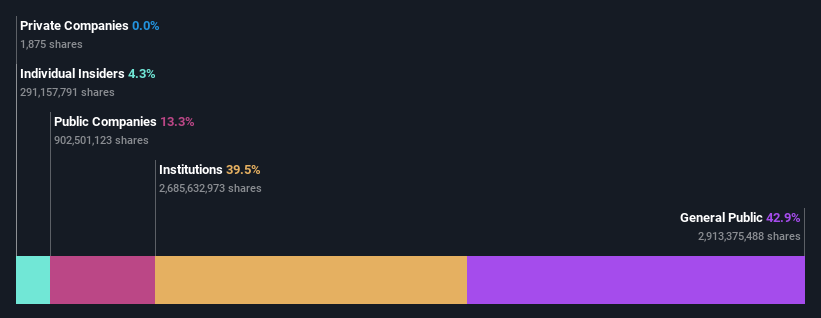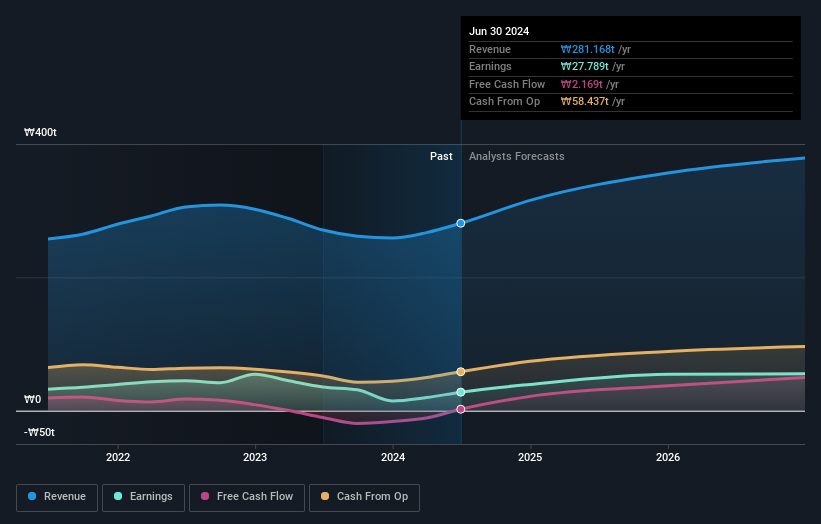Key Insights
- Samsung Electronics’ significant retail investors ownership suggests that the key decisions are influenced by shareholders from the larger public
- 43% of the business is held by the top 25 shareholders
- Institutions own 40% of Samsung Electronics
Every investor in Samsung Electronics Co., Ltd. (KRX:005930) should be aware of the most powerful shareholder groups. And the group that holds the biggest piece of the pie are retail investors with 43% ownership. Put another way, the group faces the maximum upside potential (or downside risk).
Following a 3.1% decrease in the stock price last week, retail investors suffered the most losses, but institutions who own 40% stock also took a hit.
In the chart below, we zoom in on the different ownership groups of Samsung Electronics.
View our latest analysis for Samsung Electronics

What Does The Institutional Ownership Tell Us About Samsung Electronics?
Institutional investors commonly compare their own returns to the returns of a commonly followed index. So they generally do consider buying larger companies that are included in the relevant benchmark index.
We can see that Samsung Electronics does have institutional investors; and they hold a good portion of the company’s stock. This implies the analysts working for those institutions have looked at the stock and they like it. But just like anyone else, they could be wrong. When multiple institutions own a stock, there’s always a risk that they are in a ‘crowded trade’. When such a trade goes wrong, multiple parties may compete to sell stock fast. This risk is higher in a company without a history of growth. You can see Samsung Electronics’ historic earnings and revenue below, but keep in mind there’s always more to the story.

Samsung Electronics is not owned by hedge funds. Our data shows that Samsung Life Insurance Co., Ltd. is the largest shareholder with 7.6% of shares outstanding. With 6.4% and 4.9% of the shares outstanding respectively, National Pension Service and BlackRock, Inc. are the second and third largest shareholders.
A deeper look at our ownership data shows that the top 25 shareholders collectively hold less than half of the register, suggesting a large group of small holders where no single shareholder has a majority.
While it makes sense to study institutional ownership data for a company, it also makes sense to study analyst sentiments to know which way the wind is blowing. There are plenty of analysts covering the stock, so it might be worth seeing what they are forecasting, too.
Insider Ownership Of Samsung Electronics
The definition of an insider can differ slightly between different countries, but members of the board of directors always count. Company management run the business, but the CEO will answer to the board, even if he or she is a member of it.
Insider ownership is positive when it signals leadership are thinking like the true owners of the company. However, high insider ownership can also give immense power to a small group within the company. This can be negative in some circumstances.
Our most recent data indicates that insiders own some shares in Samsung Electronics Co., Ltd.. The insiders have a meaningful stake worth ₩22t. Most would say this shows a good alignment of interests between shareholders and the board. Still, it might be worth checking if those insiders have been selling.
General Public Ownership
The general public– including retail investors — own 43% stake in the company, and hence can’t easily be ignored. This size of ownership, while considerable, may not be enough to change company policy if the decision is not in sync with other large shareholders.
Public Company Ownership
Public companies currently own 13% of Samsung Electronics stock. It’s hard to say for sure but this suggests they have entwined business interests. This might be a strategic stake, so it’s worth watching this space for changes in ownership.
Next Steps:
I find it very interesting to look at who exactly owns a company. But to truly gain insight, we need to consider other information, too. Consider for instance, the ever-present spectre of investment risk. We’ve identified 1 warning sign with Samsung Electronics , and understanding them should be part of your investment process.
If you are like me, you may want to think about whether this company will grow or shrink. Luckily, you can check this free report showing analyst forecasts for its future.
NB: Figures in this article are calculated using data from the last twelve months, which refer to the 12-month period ending on the last date of the month the financial statement is dated. This may not be consistent with full year annual report figures.
New: Manage All Your Stock Portfolios in One Place
We’ve created the ultimate portfolio companion for stock investors, and it’s free.
• Connect an unlimited number of Portfolios and see your total in one currency
• Be alerted to new Warning Signs or Risks via email or mobile
• Track the Fair Value of your stocks
Have feedback on this article? Concerned about the content? Get in touch with us directly. Alternatively, email editorial-team (at) simplywallst.com.
This article by Simply Wall St is general in nature. We provide commentary based on historical data and analyst forecasts only using an unbiased methodology and our articles are not intended to be financial advice. It does not constitute a recommendation to buy or sell any stock, and does not take account of your objectives, or your financial situation. We aim to bring you long-term focused analysis driven by fundamental data. Note that our analysis may not factor in the latest price-sensitive company announcements or qualitative material. Simply Wall St has no position in any stocks mentioned.





